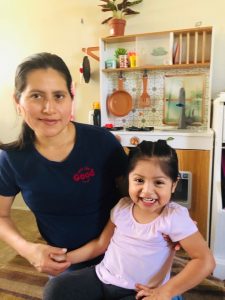Monica Mendez’s 2 year-old daughter, Mia, was not handling self-isolation very well. Mia began screaming and hitting her family members as she grew more frustrated with not being able to do the things she normally did, such as going to the park to play with her friends. And when she exhausted herself, Mia would lie on the floor, staring blankly at the ceiling.
“My daughter has difficulty with transitions and big life events,” said Mendez, who participates in Venice Family Clinic’s Children First Early Head Start program and has been a Clinic patient herself since she was born. “She didn’t understand why she couldn’t see her friends or why [Early Head Start home visitor] Gabriela couldn’t come and visit.
“But Gabriela gave me tips on how I can support my daughter and understand her perspective. My perspective of what’s happening with COVID-19 can be completely different from a 2-year-old’s,” she said. “I question myself a lot as a first-time mom, but talking to Gabriela is validating. Hearing ‘you’re a good parent’ goes a long way during this time.”
Children First Early Head Start is Venice Family Clinic’s comprehensive child development program for families with children from birth to 3 years old and pregnant mothers. The federally funded program, which currently serves 376 low-income families on the Westside of Los Angeles, Inglewood and South Bay, promotes the health and well-being of young children and their families by helping parents learn about their child’s needs, and strengthening the bond between parent and child.
The program normally includes weekly 90-minute home visits, when home visitors engage the family in activities that are both fun and educational. Home visitors also observe how the families interact; conduct developmental assessments; screen the child’s dental, hearing and vision health; perform home safety checks; and refer parents to community resources that can help them meet their basic needs. Prior to the start of the Safer at Home order, families were also invited to attend special playgroups at our clinics, which normally happen twice a month.
But now, with the need for social distancing to ensure the health and safety of our families and our staff, in-home visits and in-person playgroups are not an option.
Instead, our home visitors have gotten creative with how they maintain social connections and continue to provide support, education, and resources and supplies to their families.
Mixing it up
Home visitor Gabriela De Loza used to sing and dance with her families during home visits, which she said got the children excited to take part in their sessions. Without being able to engage families in person, she has had to adjust her approach. De Loza still sings, but now it’s by video.
She customizes content for each family, making videos of herself singing the songs and reading the books that the children liked from their previous visits. Brown Bear, Brown Bear, What do You See? by Bill Martin Jr. and Eric Carle is a favorite: “My babies love it,” she said. De Loza sends these videos, along with exercises that parents can do with their children on their own that support their child’s cognitive and language development. For the families that have the technology to support it, De Loza will hold visits by video call so she can sing and read books with the children; otherwise, she holds visits via telephone.
Once a week, De Loza and other home visitors are also dropping off much-needed supplies, thanks to generous donations from private donors and corporations. These have included fresh produce and pantry items, diapers and wipes, art supplies, books, shampoo and soap, and grocery store gift cards.
“Parents are saying their kids like the videos I send them, that they recognize me,” De Loza said. “A parent told her child that a book was from me, and the kid hugged it and said, ‘Gaby gave me a gift.’”

Meeting a need
These efforts have been so successful that home visits are up 25%, said Stacey Scarborough, director of the Clinic’s Children First Early Head Start program. And during a recent parent training held via video conference, 32 families joined, more than the usual turnout. In an effort to maintain consistency, monthly educational meetings like this one have continued – just in a new way.
“We even held a raffle like we would traditionally do. We’re trying to keep everything as normal as possible,” Scarborough said. “Our families are totally engaged and involved. They love getting the supplies. This mixed approach of phone and video visits and dropping off supplies is really working well, under these difficult circumstances.”
For program participant and Clinic patient Lourdes Santiago, receiving the bags of food has been a stress-reliever. Like so many other low-income families, anxiety over job loss and safety has been nearly all-consuming.
“With my husband not working, money has been tight,” said Santiago, whose 3-year-old daughter, Ximena, is a part of the program and whose older daughter also went through the program when she was younger. “And I don’t feel like I can go out to buy food or to any of the free food giveaways, because I’m scared to use public transportation, and I can’t drive. I am so grateful to Gabriela for bringing us food.”
“I feel empowered by Gabriela,” Santiago said. “She shares helpful resources with me that I can use to help educate my children and guide them to be successful. She makes me feel supported and secure. I feel like a better mother. And my children are doing well because of it.”
